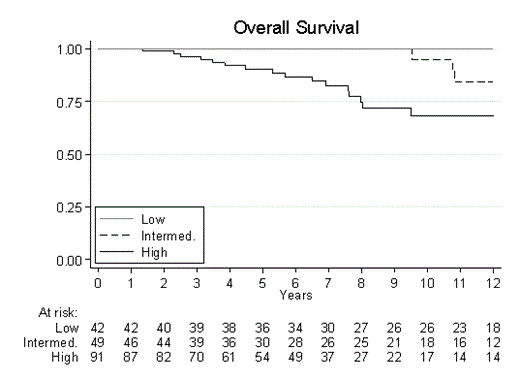Abstract
Polycythemia vera (PV) is a myeloproliferative neoplasm. Life expectancy of PV patients is reduced compared with general population; the course of disease is mainly marked out by thrombosis, with an incidence of about 18 x 1000 person-years and accounting for 45% of all deaths, but also by evolution to myelofibrosis (pPV-MF) and to acute myeloid leukemia (AML), both occurring with an incidence of 5 x 1000 person-years and accounting for 13% of deaths. Recently, in a large study published by IWG-MRT (Tefferi et al, Leukemia 2013) authors developed a widely applicable prognostic model, outlining three different prognostic risk groups based on age (age ≥67 years, 5 points; age 57–66 years, 2 points), leukocyte count (≥15 x109/l, 1 point) and venous thrombosis (1 point) as risk factors.
The aim of this study was to test this prognostic score on a retrospective consecutive series of 204 World Health Organization-defined PV patients, diagnosed from 1974 to 2013 in a single centre in Turin (Italy).
We evaluated overall survival (OS) from diagnosis to death by the Kaplan Meyer method and Hazard Ratios were estimated with the Cox Models. The cumulative incidence of death due to leukemic transformation or evolution in myelofibrosis was estimated by the method proposed by Gooley et al, accounting for competing events.
Clinical characteristics at diagnosis were: median age 65 years (31% under 57 years), 104 (51%) were male, constitutional symptoms and palpable splenomegaly were observed in 42 (21%) and 36 (18%) patients, respectively. Twenty-one (10%) patients showed leucocytosis (≥15 x 109/L) whereas thrombocytosis (≥450 x 109/L) was present in 77 (38%) patients. Fifty-three patients had previous thrombotic events (40 arterious and 13 venous). As expected, approximately 94% of the patients were positive for JAK2 mutations (V617F or exon12) analysis, performed at diagnosis or during the course of disease if PV was diagnosed before 2005.
At a median follow-up of 93 months we observed 27 (13%) deaths, 26 (13%) myelofibrotic transformations and 7 (3%) leukemic evolution. The incidence of post diagnosis arterial vs venous thrombosis and major haemorrhage were 15%, 11% and 9% respectively
The overall survival at 10 years was 85.3% (95%CI:77.6-90.5) and the cumulative incidence of death due to leukemic transformation or evolution in myelofibrosis adjusted for competitive risk event was 9.8% (95%IC: 4.5-15.0).
According to the IWG-MRT score, patients were subdivided into three groups: low-risk (0 points), intermediate-risk (1 or 2 points) and high-risk (≥3 points) patients. The prognostic model showed a good discrimination between high-risk (n= 91; 10-year survival 68.3%; vs low-risk HR 8.48; 95%CI: 1.94-37.16), intermediate-risk (n= 49; 10-year survival 94.7%; vs low-risk HR 3.23; 95%CI: 0.62-16.68) and low-risk (n= 42; 10-year survival 100%) patient groups (fig1). The C-statistic was 0.751.
Of note, in our analysis age was the prognostic factor at highest impact on OS (fig2); when we consider the older age as a only prognostic factor the discrimination between risk group was similar to those defined by IWG-MRT. The C-statistic was 0.748. We did not analyse the impact of leucocytosis and venous thrombosis in younger patients (at low risk according to IWG-MRT score) due to low number of events in our cohort.
The IWG-MRT prognostic score was confirmed as a good predictor of survival and prognosis in a retrospective cohort of consecutive PV patients. Moreover older age resulted as the prognostic factor at highest impact on OS.
No relevant conflicts of interest to declare.
Author notes
Asterisk with author names denotes non-ASH members.



This feature is available to Subscribers Only
Sign In or Create an Account Close Modal